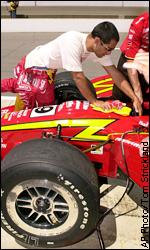ALSO SEE
Notebook: Drivers attempt to get comfortable
Little Al blasts 'aggressive' Montoya
AUDIO/VIDEO

 Greg Ray talks with RPM 2Night's Marlo Klain about pole position and the competition. Greg Ray talks with RPM 2Night's Marlo Klain about pole position and the competition.
RealVideo: | 28.8

 Eddie Cheever doesn't want to overdo it before race day. Eddie Cheever doesn't want to overdo it before race day.
wav: 78 k
RealAudio: 14.4 | 28.8 | 56.6
 Juan Montoya was pleased with Thursday's results. Juan Montoya was pleased with Thursday's results.
wav: 95 k
RealAudio: 14.4 | 28.8 | 56.6
 Buddy Lazier and crew are in good shape. Buddy Lazier and crew are in good shape.
wav: 96 k
RealAudio: 14.4 | 28.8 | 56.6
|


